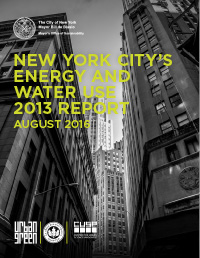 For the first time, data submitted by some of the NYC’s biggest buildings under Local Law 84 (benchmarking) and Local Law 87 (auditing) have been analyzed together to give a clear picture not only of the amount of energy and water used by these buildings, but also what heating, cooling, and other systems are being used.
For the first time, data submitted by some of the NYC’s biggest buildings under Local Law 84 (benchmarking) and Local Law 87 (auditing) have been analyzed together to give a clear picture not only of the amount of energy and water used by these buildings, but also what heating, cooling, and other systems are being used.
This data, presented in the New York City’s Energy and Water Use 2013 Report, gives unprecedented insights into how buildings operate (whether efficiently or not), and what can be done to improve performance.
Congratulations to the Urban Green Council, the Mayor’s Office of Sustainability and the NYU Center for Urban Science and Progress for the comprehensive reporting.
Summary of key findings from the report:
- In general, the report found that NYC buildings have reduced greenhouse gas emissions by 8% and energy use by 6%.
- Buildings consistently benchmarked under LL84 show strong reductions in both building energy use and carbon emissions
- While the citywide ENERGY STAR Score (of 74) is well above the median (of 50), NYC buildings still have a ways to go to catch up with other urban areas that benchmark.
- Space heating is New York’s largest single energy demand. Click here to access the interactive version of the graph pictured below to track the heating systems used. According to the New York Daily News, “three quarters of the spaces surveyed used steam heat, which can be replaced by more efficient systems.”
Insights:
Data Centers: “Given the huge growth in data center and associated cooling usage over the past 20 years, it is remarkable that the savings achieved in total energy are as large as they are for commercial buildings. This shows how hard Energy Managers and Facility Engineers are working to avoid wasting energy in common areas, and often succeeding,” says Sheila Sweeney, Great Forest’s Director of Energy Services.
“That said, the fact that so few Energy Conservation Measures (ECMs) are recommended around those technologies (see figure 20 p. 28 of the report) means that the other electricity ECMs (lighting, cooling) are vulnerable to having their savings erased in the future by expansion of existing financial services floor space. So we strongly encourage ownership attention to the growth of data centers in tenant spaces.”
Local Law 88: Clients who are anticipating the need to comply with Local Law 88 submetering/lighting upgrades for tenants, mandated by 2025, will find ample evidence of the benefits of early compliance in this report.
Green House Gas Emissions: With ENERGY STAR Portfolio Manager’s new tool to track waste, we hope that within a few years there will be detailed GHG data generated by buildings’ waste and diversion reporting. You can read all about the EPA’s efforts in this area here.
Top Ways NYC Can Improve Efficiency
According to the report, buildings should:
- Improve heating efficiency: refurbishing and replacing steam heating systems can yield deep energy savings.
- Reduce energy loss from air conditioners: Leaks from window and wall air-conditioning units—roughly equivalent to punching a six-square-inch hole in your wall—are costing building owners up to $180 million every year.
- Update lighting: Roughly 40% of multifamily buildings and 25% of offices are lit by older, inefficient and poorly controlled systems. Only 10% of buildings had automatic light controls, which can turn off lights when not in use.
Download/Read the full report.

